King's
Canadian Red Cross
Special Hospital
Special Hospital
Upper Lodge, Bushy
Park, Hampton Hill, Middlesex TW12 1NE
Medical
dates:
Medical
character:
Convalescent (military)
In 1915 King George V gave
permission to the Canadian Red Cross for Upper Lodge
at Hampton Hill to be used as a hospital for Canadian troops stationed
in Bushy Park.
The King's Canadian Red Cross Convalescent Hospital opened on 27th December 1915 with 30 beds. By 31st December all were occupied.
On the day the furniture arrived, 22nd December, Queen Mary had visited. The beds and bedding and other necessary items had been supplied by the Duchess of Connaught Canadian Convalescent Hospital at Taplow, Bucks.
A letter had been received from a lady just before Christmas enquiring how many patients would be expected to be in the Hospital on Christmas Day. A reply was sent, saying that possibly there would be 20. A munificent gift was greatly anticipated. When the package arrived, it was found to contain 20 lavender bags, each with an accompanying text of scripture.
The mansion, once the home of Lady Paget, had been vacant for two years and had fallen into decay. The grounds, orchard and garden had been neglected and had run wild. During the next six months the underbrush in the woods was cleared away, the trees and hedges trimmed, new ornamental flower beds laid out and the paths regraded. The extensive vegetable garden was weeded, dug over and planted, and the trees in the orchard pruned and sprayed.
At first the administrative offices of the Hospital were located some 2 miles away at the Greyhound Hotel in Hampton Court. In the middle of January 1916 they moved into Upper Lodge.
It was anticipated that the Hospital would cost about £24,000 to build. On 16th March 1916, while the ward hutments were being erected and the buildings and grounds were being restored, the King and Queen visited the Hospital. As their car approached the main gate into the grounds, its wheels became embedded in mud. The Royal visitors, in good humour, completed their journey on foot. Having inspected the Hospital from cellar to garret, they complimented the Canadians on the successful restoration of the site.
The new ward buildings were constructed with asbestos walls on brick foundations. The Administrative Building was completed in April 1916. Those who had been billeted out were then moved into the mansion (senior staff) and the stables (personnel). As the number of personnel increased over the summer, tents were pitched for them in one of the paddocks.
On 15th May 1916 a dental clinic was established at the Lodge. A dispensary and laboratory were later added.
By June 1916 the Hospital had hutted accommodation for 250 patients. Each hut was a complete unit in itself and independent of the wards in the mansion. The new wards were large, airy and cheerful in appearance. In another part of the grounds, a Billiard Room had been built for the patients. There was also a commodious Recreation-cum-Concert Hall - the gift of Mrs Robert Gooderham of Toronto - where patients could read, write letters, play the piano or listen to music, or play cards and other games. Canadian and British newspapers and periodicals were provided by their publishers and others. Theatrical entertainments and concerts were held in the Hall in the evenings.
By August 1916 six wings of the Hospital had been completed and equipped by the Canadian Red Cross Society. Each wing bore the name of one of the King's children.
In the autumn a large Physical Training and Gymnasium Building was added but, because of the incessant demand for more patient accommodation, it was soon fitted up as a hospital ward.
On 11th September 1916 the Hospital acquired an auxiliary hospital at Clarence House in Roehampton. Twenty patients were despatched to the new convalescent hospital but had to return as there had been a misunderstanding about opening dates. It was not until 13th October that authority for Clarence House Convalescent Hospital to receive patients was given. Forty convalescents were then transferred there and, by the end of the month, Clarence House was accommodating 100 patients.
During November 1916 the average number of patients in the Hospital and Clarence House was 436, of whom 75 were amputees.
The Canadian Red Cross Society provided food supplies for the Hospital at the daily cost of 1 shilling 5 pence (7p) per head. Comforts for the troops - cigarettes, tobacco, shaving-kit bags and other utility items, apples, games and reading matter - were also provided by the Society, as well as by the Provincial Governments.
In December 1916 the local residents of Hampton Hill decided unanimously to open and staff a canteen at the Fitz Wygram Coffee Tavern for the patients.
By March 1917 the Hospital had 289 beds, with an additional 109 at Clarence House. In April both sites accommodated 375 patients, who stayed 15 days on average.
In April 1917 control of the Hospital passed from the Canadian Red Cross Society to the Canadian military authorities.
By May 1917 the Hospital had 400 beds - 291 at Bushy Park and 109 at Clarence House. Special clinics were established for patients with heart disease and trench nephritis.
In the autumn of 1917 a new and larger Physical Training pavilion was erected.
In October 1917 the number of beds was increased from 291 to 321 at Bushy Park and from 109 to 129 at Clarence House.
On 29th October the Hospital was renamed the King's Canadian Red Cross Special Hospital. Its staff consisted of 12 officers and 78 other ranks.
In November 1917 the Hospital had 344 beds, with 106 at Clarence House. There were 7 officers on the staff, 6 nursing sisters and 82 other ranks. By the end of the month the Nephritis Clinic had treated 464 patients since its establishment on 8th May. Of these, 71 (22%) had been invalided back to Canada.
In March 1918 the Hospital had 406 beds - 300 at Bushy Park and 106 at Clarence House.
By May 1918 the staff consisted of 10 officers, 6 nursing sisters, 90 other ranks and 5 civilians.
Following the end of the war the patients and personnel were gradually evacuated over May, June and July 1919. By 14th July there remained only 3 officers and 6 servicemen in residence. The buildings and wards were redecorated in anticipation of handing over the site to the LCC for use as an open-air school for children from the East End with TB and other respiratory disorders.
The Hospital was officially disbanded on 2nd September 1919.
Present status (February 2010)
The Canadian Red Cross Society gave up all its ward buildings and much of its equipment for the new school, which was named the King's Canadian Residential Open Air School. The School closed in 1939 on the outbreak of WW2.
The buildings remained unused until 1942, when the United States entered the war. The US 8th Army Air Force took over the site as its headquarters, renaming it Camp Griffiss, after Lt Col Townsend Griffiss, the first American airman to be killed in the line of duty in Europe. In 1944 the Supreme Headquarters of the Allied Expeditionary Force (SHAEF) under the command of General Dwight Eisenhower moved to Bushy Park. The initial planning stages of the allied invasion of Normandy, code-named Operation Overlord, took place here.
In 1945 control of Upper Lodge was transferred from the Air Ministry to the Admiralty. It became part of the Admiralty Research Laboratory; the Longford River (a canal which fed the pools of the Water Gardens) was diverted so that the still water could be used for testing mines.
By 1963 most of the temporary hutments used by the Hospital and the camps had been cleared from the site.
In 1994 the Ministry of Defence relinquished the lease of Upper Lodge to the Crown Estate.
Upper Lodge and the stables were sold for residential development and are now apartment blocks.
Bushy Park remains a public park. A totem pole and the Canadian Glade in the Waterhouse Woodland Garden commemorate the use of the park by the Canadians during WW1. The park also contains several memorials to the American Forces during WW2.
The King's Canadian Red Cross Convalescent Hospital opened on 27th December 1915 with 30 beds. By 31st December all were occupied.
On the day the furniture arrived, 22nd December, Queen Mary had visited. The beds and bedding and other necessary items had been supplied by the Duchess of Connaught Canadian Convalescent Hospital at Taplow, Bucks.
A letter had been received from a lady just before Christmas enquiring how many patients would be expected to be in the Hospital on Christmas Day. A reply was sent, saying that possibly there would be 20. A munificent gift was greatly anticipated. When the package arrived, it was found to contain 20 lavender bags, each with an accompanying text of scripture.
The mansion, once the home of Lady Paget, had been vacant for two years and had fallen into decay. The grounds, orchard and garden had been neglected and had run wild. During the next six months the underbrush in the woods was cleared away, the trees and hedges trimmed, new ornamental flower beds laid out and the paths regraded. The extensive vegetable garden was weeded, dug over and planted, and the trees in the orchard pruned and sprayed.
At first the administrative offices of the Hospital were located some 2 miles away at the Greyhound Hotel in Hampton Court. In the middle of January 1916 they moved into Upper Lodge.
It was anticipated that the Hospital would cost about £24,000 to build. On 16th March 1916, while the ward hutments were being erected and the buildings and grounds were being restored, the King and Queen visited the Hospital. As their car approached the main gate into the grounds, its wheels became embedded in mud. The Royal visitors, in good humour, completed their journey on foot. Having inspected the Hospital from cellar to garret, they complimented the Canadians on the successful restoration of the site.
The new ward buildings were constructed with asbestos walls on brick foundations. The Administrative Building was completed in April 1916. Those who had been billeted out were then moved into the mansion (senior staff) and the stables (personnel). As the number of personnel increased over the summer, tents were pitched for them in one of the paddocks.
On 15th May 1916 a dental clinic was established at the Lodge. A dispensary and laboratory were later added.
By June 1916 the Hospital had hutted accommodation for 250 patients. Each hut was a complete unit in itself and independent of the wards in the mansion. The new wards were large, airy and cheerful in appearance. In another part of the grounds, a Billiard Room had been built for the patients. There was also a commodious Recreation-cum-Concert Hall - the gift of Mrs Robert Gooderham of Toronto - where patients could read, write letters, play the piano or listen to music, or play cards and other games. Canadian and British newspapers and periodicals were provided by their publishers and others. Theatrical entertainments and concerts were held in the Hall in the evenings.
By August 1916 six wings of the Hospital had been completed and equipped by the Canadian Red Cross Society. Each wing bore the name of one of the King's children.
In the autumn a large Physical Training and Gymnasium Building was added but, because of the incessant demand for more patient accommodation, it was soon fitted up as a hospital ward.
On 11th September 1916 the Hospital acquired an auxiliary hospital at Clarence House in Roehampton. Twenty patients were despatched to the new convalescent hospital but had to return as there had been a misunderstanding about opening dates. It was not until 13th October that authority for Clarence House Convalescent Hospital to receive patients was given. Forty convalescents were then transferred there and, by the end of the month, Clarence House was accommodating 100 patients.
During November 1916 the average number of patients in the Hospital and Clarence House was 436, of whom 75 were amputees.
The Canadian Red Cross Society provided food supplies for the Hospital at the daily cost of 1 shilling 5 pence (7p) per head. Comforts for the troops - cigarettes, tobacco, shaving-kit bags and other utility items, apples, games and reading matter - were also provided by the Society, as well as by the Provincial Governments.
In December 1916 the local residents of Hampton Hill decided unanimously to open and staff a canteen at the Fitz Wygram Coffee Tavern for the patients.
By March 1917 the Hospital had 289 beds, with an additional 109 at Clarence House. In April both sites accommodated 375 patients, who stayed 15 days on average.
In April 1917 control of the Hospital passed from the Canadian Red Cross Society to the Canadian military authorities.
By May 1917 the Hospital had 400 beds - 291 at Bushy Park and 109 at Clarence House. Special clinics were established for patients with heart disease and trench nephritis.
In the autumn of 1917 a new and larger Physical Training pavilion was erected.
In October 1917 the number of beds was increased from 291 to 321 at Bushy Park and from 109 to 129 at Clarence House.
On 29th October the Hospital was renamed the King's Canadian Red Cross Special Hospital. Its staff consisted of 12 officers and 78 other ranks.
In November 1917 the Hospital had 344 beds, with 106 at Clarence House. There were 7 officers on the staff, 6 nursing sisters and 82 other ranks. By the end of the month the Nephritis Clinic had treated 464 patients since its establishment on 8th May. Of these, 71 (22%) had been invalided back to Canada.
In March 1918 the Hospital had 406 beds - 300 at Bushy Park and 106 at Clarence House.
By May 1918 the staff consisted of 10 officers, 6 nursing sisters, 90 other ranks and 5 civilians.
Following the end of the war the patients and personnel were gradually evacuated over May, June and July 1919. By 14th July there remained only 3 officers and 6 servicemen in residence. The buildings and wards were redecorated in anticipation of handing over the site to the LCC for use as an open-air school for children from the East End with TB and other respiratory disorders.
The Hospital was officially disbanded on 2nd September 1919.
Present status (February 2010)
The Canadian Red Cross Society gave up all its ward buildings and much of its equipment for the new school, which was named the King's Canadian Residential Open Air School. The School closed in 1939 on the outbreak of WW2.
The buildings remained unused until 1942, when the United States entered the war. The US 8th Army Air Force took over the site as its headquarters, renaming it Camp Griffiss, after Lt Col Townsend Griffiss, the first American airman to be killed in the line of duty in Europe. In 1944 the Supreme Headquarters of the Allied Expeditionary Force (SHAEF) under the command of General Dwight Eisenhower moved to Bushy Park. The initial planning stages of the allied invasion of Normandy, code-named Operation Overlord, took place here.
In 1945 control of Upper Lodge was transferred from the Air Ministry to the Admiralty. It became part of the Admiralty Research Laboratory; the Longford River (a canal which fed the pools of the Water Gardens) was diverted so that the still water could be used for testing mines.
By 1963 most of the temporary hutments used by the Hospital and the camps had been cleared from the site.
In 1994 the Ministry of Defence relinquished the lease of Upper Lodge to the Crown Estate.
Upper Lodge and the stables were sold for residential development and are now apartment blocks.
Bushy Park remains a public park. A totem pole and the Canadian Glade in the Waterhouse Woodland Garden commemorate the use of the park by the Canadians during WW1. The park also contains several memorials to the American Forces during WW2.
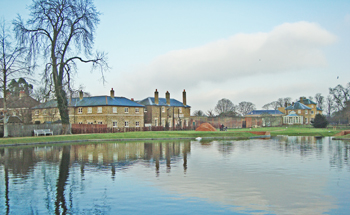
Upper Lodge, with its conservatory, is on the right of the image, with the stable buildings on the left.
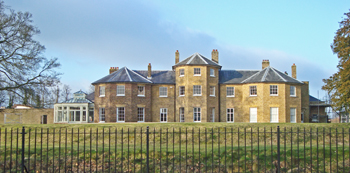
The rear elevation (above) and the side elevation (below) of the Grade II listed Upper Lodge, as seen from Bushy Park. Built around 1840, the mansion is part of the Crown Estate and was a 'grace and favour' home until 1915. It was sold for almost £8.85m.
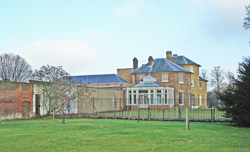
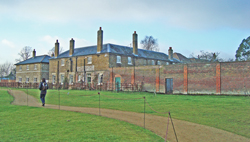
The extensive stables buildings were used for Hospital staff accommodation.
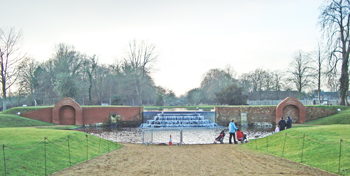
The restored Water Gardens in Bushy Park were opened to the public in 2009.

In 1992 a totem pole was installed in the Woodland Gardens, north of the Waterhouse Pond, as a memorial to the connection with Canada. With a killer whale - the monarch of the sea - depicted at its base, and an eagle - the monarch of the air - at its top, it represents contact - first by sea and then by air - between Europeans and the native North American population.
(Author unstated) 1916 Notes. Canadian Red Cross Society. British Medical Journal 2 (2899), 125.
http://archive.org
http://bnatopics.org
http://data4.collectionscanada.qc.ca
http://en.wikipedia.org
www.britishlistedbuildings.co.uk (1)
www.britishlistedbuildings.co.uk (2)
www.collectionscanada.gc.ca
www.archive.org
www.fbhp.org.uk
www.gilliesarchives.org.uk
www.ourhampton.org
www.royalparks.org.uk
www.twickenham-museum.org.uk
www2.richmond.gov.uk
Return to home page